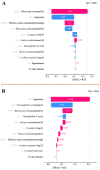Mortality prediction in patients with hyperglycaemic crisis using explainable machine learning: a prospective, multicentre study based on tertiary hospitals
- PMID: 36899433
- PMCID: PMC10007769
- DOI: 10.1186/s13098-023-01020-1
Mortality prediction in patients with hyperglycaemic crisis using explainable machine learning: a prospective, multicentre study based on tertiary hospitals
Abstract
Background: Experiencing a hyperglycaemic crisis is associated with a short- and long-term increased risk of mortality. We aimed to develop an explainable machine learning model for predicting 3-year mortality and providing individualized risk factor assessment of patients with hyperglycaemic crisis after admission.
Methods: Based on five representative machine learning algorithms, we trained prediction models on data from patients with hyperglycaemic crisis admitted to two tertiary hospitals between 2016 and 2020. The models were internally validated by tenfold cross-validation and externally validated using previously unseen data from two other tertiary hospitals. A SHapley Additive exPlanations algorithm was used to interpret the predictions of the best performing model, and the relative importance of the features in the model was compared with the traditional statistical test results.
Results: A total of 337 patients with hyperglycaemic crisis were enrolled in the study, 3-year mortality was 13.6% (46 patients). 257 patients were used to train the models, and 80 patients were used for model validation. The Light Gradient Boosting Machine model performed best across testing cohorts (area under the ROC curve 0.89 [95% CI 0.77-0.97]). Advanced age, higher blood glucose and blood urea nitrogen were the three most important predictors for increased mortality.
Conclusion: The developed explainable model can provide estimates of the mortality and visual contribution of the features to the prediction for an individual patient with hyperglycaemic crisis. Advanced age, metabolic disorders, and impaired renal and cardiac function were important factors that predicted non-survival.
Trial registration number: ChiCTR1800015981, 2018/05/04.
Keywords: Explainable model; Hyperglycaemic crisis; Machine learning; Mortality.
© 2023. The Author(s).
Conflict of interest statement
The authors report no potential conflicts of interest relevant to this article.
Figures



Similar articles
-
Dynamic and explainable machine learning prediction of mortality in patients in the intensive care unit: a retrospective study of high-frequency data in electronic patient records.Lancet Digit Health. 2020 Apr;2(4):e179-e191. doi: 10.1016/S2589-7500(20)30018-2. Epub 2020 Mar 12. Lancet Digit Health. 2020. PMID: 33328078
-
Development and Validation of an Explainable Machine Learning Model for Major Complications After Cytoreductive Surgery.JAMA Netw Open. 2022 May 2;5(5):e2212930. doi: 10.1001/jamanetworkopen.2022.12930. JAMA Netw Open. 2022. PMID: 35612856 Free PMC article.
-
A novel explainable online calculator for contrast-induced AKI in diabetics: a multi-centre validation and prospective evaluation study.J Transl Med. 2023 Jul 31;21(1):517. doi: 10.1186/s12967-023-04387-x. J Transl Med. 2023. PMID: 37525240 Free PMC article.
-
Interpretable machine learning for predicting 28-day all-cause in-hospital mortality for hypertensive ischemic or hemorrhagic stroke patients in the ICU: a multi-center retrospective cohort study with internal and external cross-validation.Front Neurol. 2023 Aug 8;14:1185447. doi: 10.3389/fneur.2023.1185447. eCollection 2023. Front Neurol. 2023. PMID: 37614971 Free PMC article.
-
Machine-learning Models Predict 30-Day Mortality, Cardiovascular Complications, and Respiratory Complications After Aseptic Revision Total Joint Arthroplasty.Clin Orthop Relat Res. 2022 Nov 1;480(11):2137-2145. doi: 10.1097/CORR.0000000000002276. Epub 2022 Jun 20. Clin Orthop Relat Res. 2022. PMID: 35767804 Free PMC article.
Cited by
-
Efficient and Automatic Breast Cancer Early Diagnosis System Based on the Hierarchical Extreme Learning Machine.Sensors (Basel). 2023 Sep 9;23(18):7772. doi: 10.3390/s23187772. Sensors (Basel). 2023. PMID: 37765827 Free PMC article.
-
FGFR2 identified as a NETs-associated biomarker and therapeutic target in diabetic foot ulcers.Eur J Med Res. 2025 Aug 13;30(1):748. doi: 10.1186/s40001-025-03012-5. Eur J Med Res. 2025. PMID: 40796870 Free PMC article.
-
Successful Management of Extreme Hyperglycemia (134 mmol/L) Secondary to Chronic Pancreatitis Causing Critical Hyperosmolar Coma: A Case Report.Case Rep Endocrinol. 2025 Jun 3;2025:4737440. doi: 10.1155/crie/4737440. eCollection 2025. Case Rep Endocrinol. 2025. PMID: 40496635 Free PMC article.
-
Development and Validation of an Explainable Deep Learning Model to Predict In-Hospital Mortality for Patients With Acute Myocardial Infarction: Algorithm Development and Validation Study.J Med Internet Res. 2024 May 10;26:e49848. doi: 10.2196/49848. J Med Internet Res. 2024. PMID: 38728685 Free PMC article.
-
Enhancing diabetic foot ulcer prediction with machine learning: A focus on Localized examinations.Heliyon. 2024 Sep 19;10(19):e37635. doi: 10.1016/j.heliyon.2024.e37635. eCollection 2024 Oct 15. Heliyon. 2024. PMID: 39386877 Free PMC article.
References
-
- French EK, Donihi AC, Korytkowski MT. Diabetic ketoacidosis and hyperosmolar hyperglycemic syndrome: review of acute decompensated diabetes in adult patients. BMJ. 2019;365. - PubMed
Grants and funding
LinkOut - more resources
Full Text Sources

